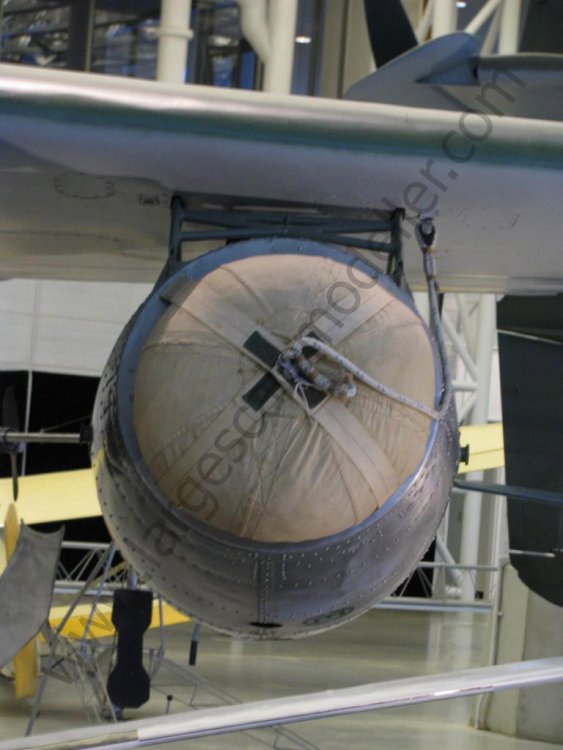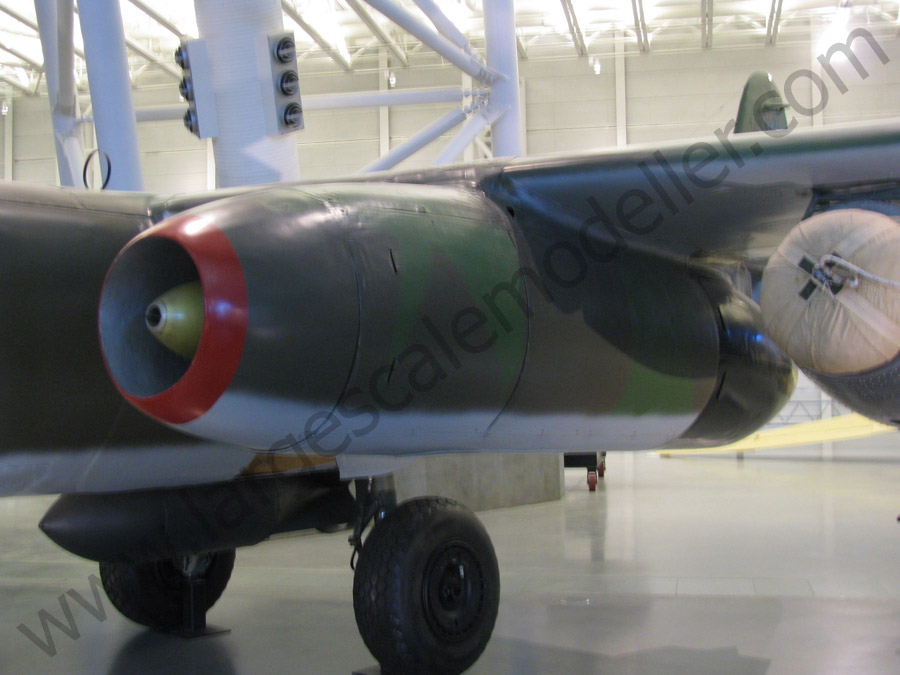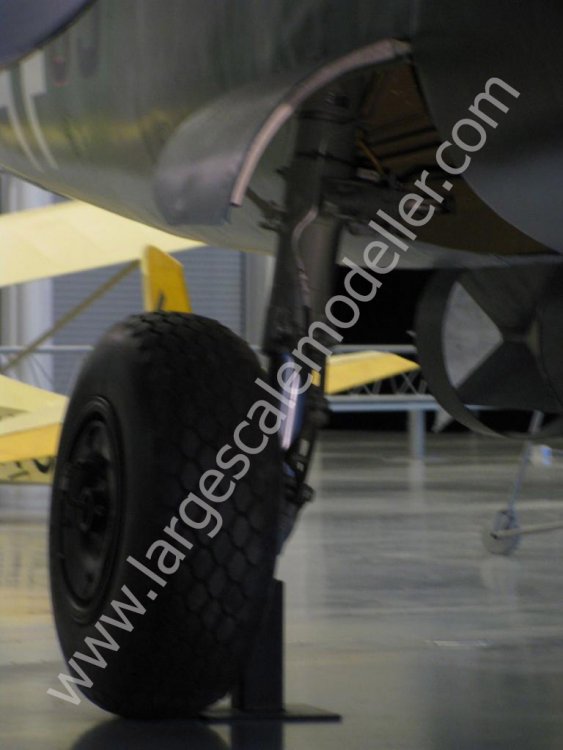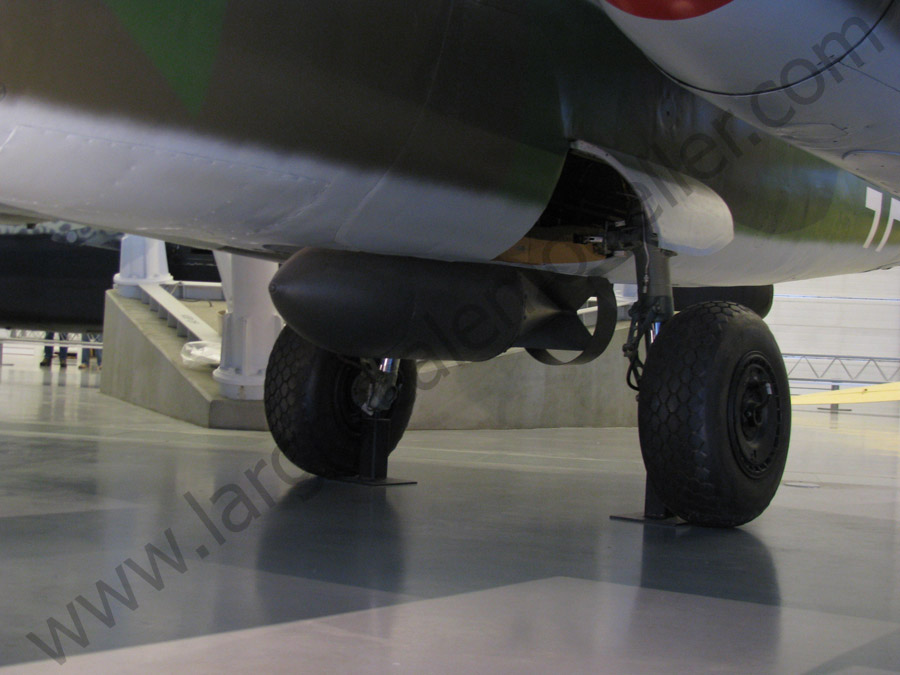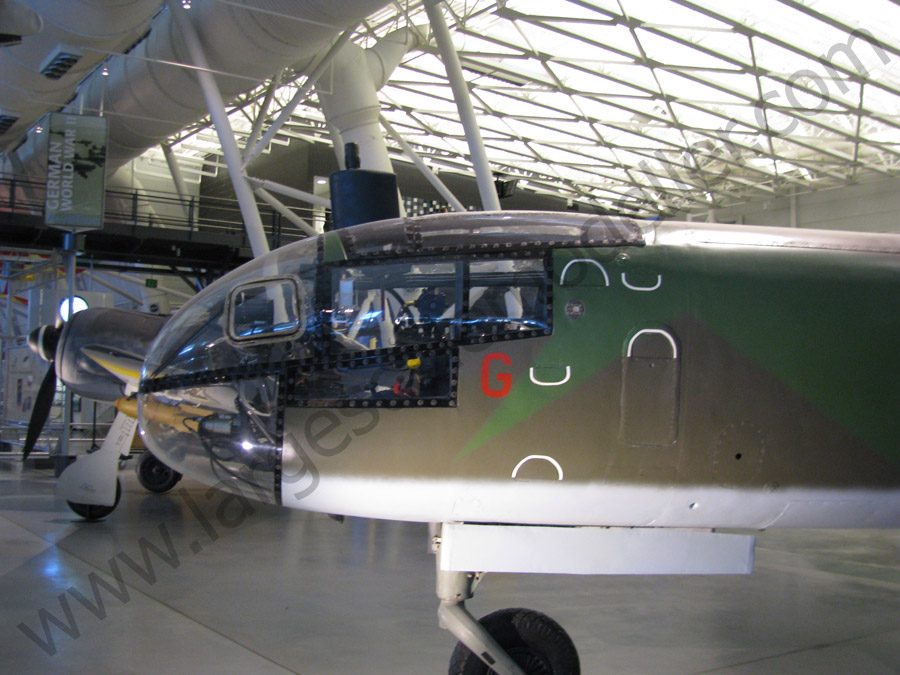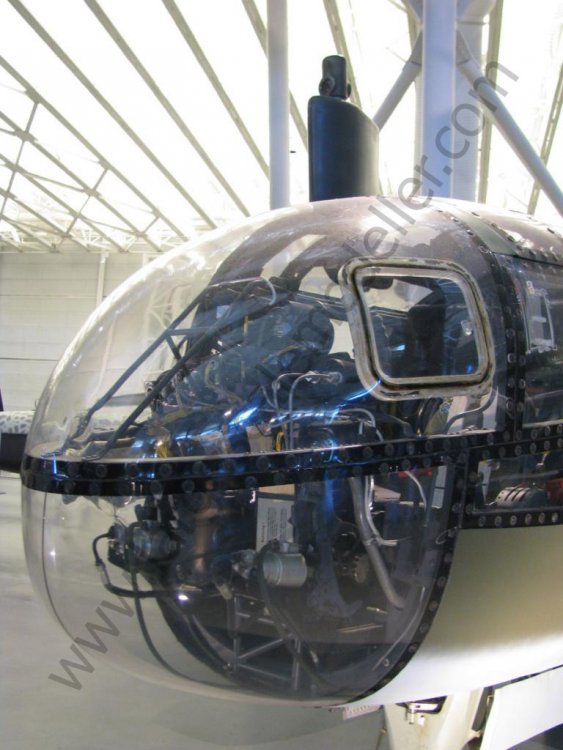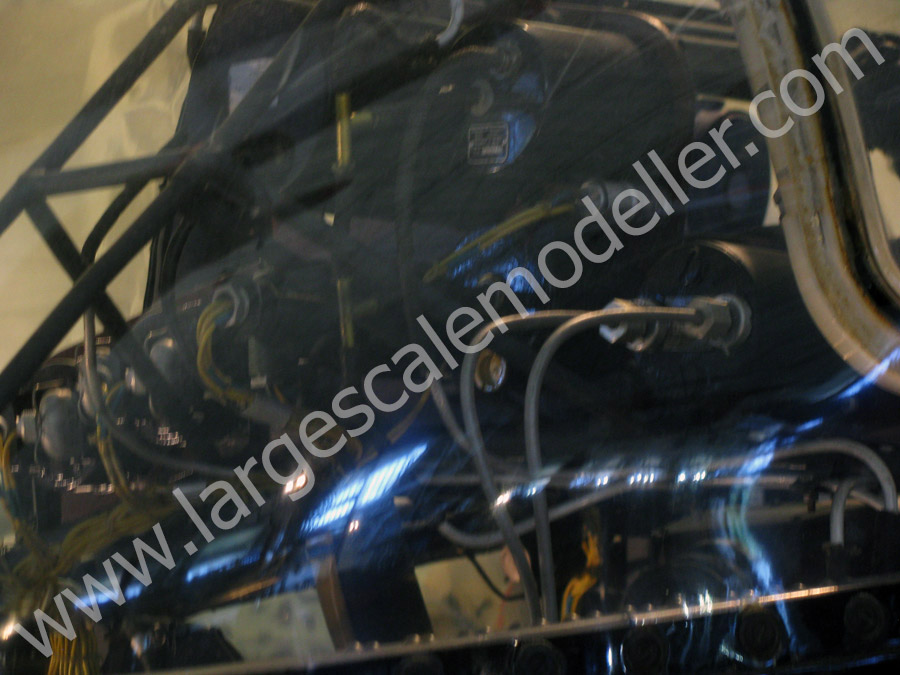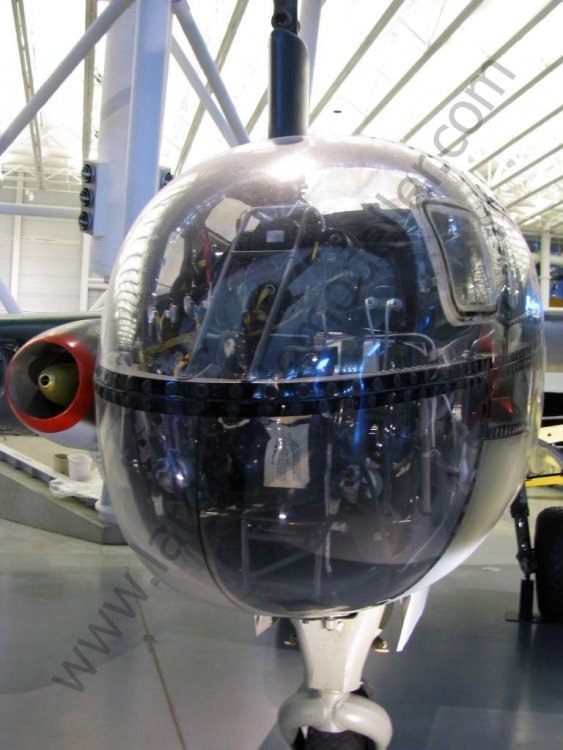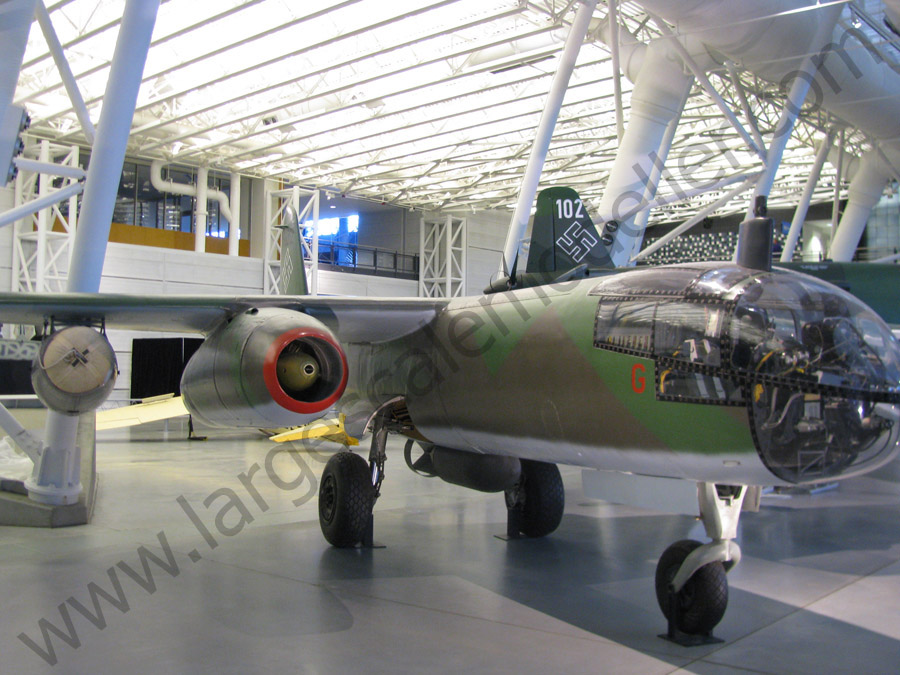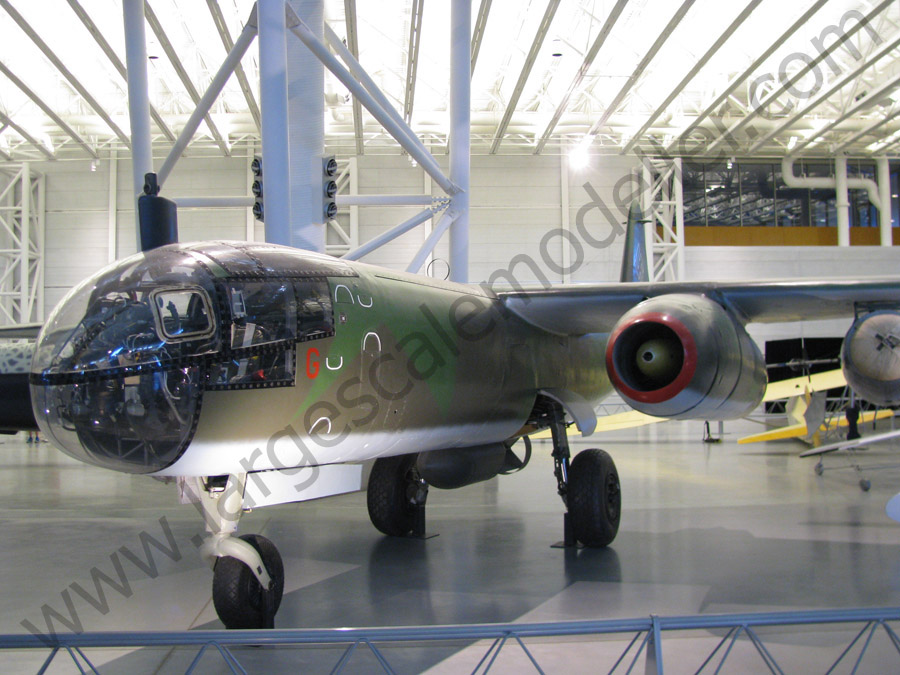-
Posts
3,257 -
Joined
-
Last visited
Content Type
Profiles
Forums
Events
Gallery
Everything posted by James H
-
Order one direct from Fly. It's still a reasonably-priced kit even with shipping from mainland Europe. One word of caution.....marking the holes in the canopy, for those antenna masts, is a real bitch!
-

Fly Arado Ar 234B-2/N "Nachtigall"
James H replied to One-Oh-Four's topic in LSM 1/35 and Larger Work In Progress
Any news here?- 25 replies
-

Fly Arado Ar 234B-2/N "Nachtigall"
James H replied to One-Oh-Four's topic in LSM 1/35 and Larger Work In Progress
hihihihihihi- 25 replies
-

Fly Arado Ar 234B-2/N "Nachtigall"
James H replied to One-Oh-Four's topic in LSM 1/35 and Larger Work In Progress
double bump...- 25 replies
-
Thanks guys, Most paint is Gunze, including the RLM66. I use Vallejo for detail painting, and I also used Mr Paint for the struts (yet to be shown) and the interior of the nacelle (also to be shown). The only aftermarket stuff here are the HGW seat belts and some Airscale instrument and placard decals. I have used lead wire and other scraps here and there, but the rest is OOB. For rivets, I use the MDC rivet tool. This is a jewellers beading tool, meaning you apply one by one. These are mostly added with the photo-etch spacing guide you see. Where the curves make it difficult, I do them freehand.
-
Pitot...AND wing riveting!! Perfect!
-
I really DO apologise for my tardiness in keeping this one up to date. When this happens, I promise that I HAVE been working, but magazine work can get seriously engrossing. Ok, much has happened with this, to the point where the model is about ready to airbrush. I thought I'd share a few images with you, and one where you can see that the night fighter version needs to have the rear area cut away to incorporate the clear glazing. OH....and I riveted the WHOLE model!!! (using a beading tool)
-
Impressive box, but I'll have nightmares about the smiley mask tonight! Nice one Terry!
-
Perhaps I can get us a few of these for the site..
-

Arado Ar-234 B-2N „Nachtigall” FLY 1:32
James H replied to Krzysztof Koza's topic in LSM 1/35 and Larger Work In Progress
Fantastic work! At this speed, you will soon overtake my build -
1:32 Horten Ho 229 Zoukei-mura Catalogue # SWS No.8 Available from Zoukei-mura for ¥13,800 (+fee) The very seed of the Horten Ho 229 project, was sown by the harsh restrictions which were forced upon Germany when she signed the Armistice at the end of The Great War. Whilst many civilians were facing untold hardship and starvation in the closing stages of the conflict, and her armies were on retreat, they still had reasonable strength that, had things been different, could have turned the tide of the war in Germany's favour. As a result, many within Germany saw the restrictions imposed by the Treaty of Versailles, as being the equivalence of military castration. Those restrictions did lack something though, and those were certain technologies which were seen to be non-militaristic, and even folly. These were the development and pursuance of activities such as gliding, and jet and rocket propulsion. As gliding become popular in 1920's Germany, leading proponents of future technologies, began to appear. Enter Reimar and Walter Horten. Their work on flying wing designs began to be noticed in the 1930's, and their activities were of particular interest to the Nazi party, and at the outbreak of war, despite both serving in the Luftwaffe, their expertise was called upon by aero engineers. When Goering issued a requirement for a new high speed bomber in 1943, the Horten brothers submitted a flying wing design, which without a traditional fuselage and tail, could reduce overall drag and result in a much sleeker, lightweight aircraft, capable of carrying the 1000kg bomb load which was stipulated in the RLM requirements. The result was a beautiful and quite imposing bat-wing style machine which was constructed from a tubular metal central section, timber and carbon composite spars, and sheathed in plywood. It was also powered by two turbojet engines, housed either side of the pilot. Several prototypes were built, and flew, with varying success, and by the end of the war, only one complete machine remained, awaiting final assembly (V3), and several were in various stages of completion. The V3 is now housed at the NASM, awaiting restoration. The Ho 229 was also known as the Go 229, after the factory at which it was built (Gothaer Waggonfabrik). Like several late war German designs, had the war not ended in 1945, production of the Ho 229 could indeed have had an effect on Allied bombing of Germany, and also very possibly have delivered its own payload of bombs to neighbouring countries. ZM's Ho 229 has been mooted for around 2 years now, and as this goes to publication, should be available from both the Volks USA and Volks Japan websites. Ours was shipped via EMS, and having many parcels arriving to our team via EMS, you will usually find this to be quite a cost-efficient and swift system of delivery. It's been quite a long time since we looked at a Zoukei-mura kit, but we firmly believe that if a kit looks interesting, then we should put it through its paces and take an honest, unbiased review of it. This is quite a reasonable-sized box for what is essentially only a wing. Yes, that tends to be the format of a flying wing, and from the very outset, the box art does tend to get you in the mood for what you'll see within. I do very much like Jerry Boucher's art, and it was this author that introduced Jerry to ZM, but I do have to ask why a Ho 229 is seen engaging a Lancaster during daylight hours. I know the Ho 229 never entered production, but unless there was a significant shift in Bomber Command strategy, the Lancaster only ever operated during the hours of darkness. Still, it is a great looking box art, and certainly will help to sell this kit. If you like lots of plastic (and who doesn't?), then this release will hit the mark immediately. If you thought that an aircraft that simply comprised a jet-powered wing would fall short on sprue count, you might be surprised to know that this kit contains no less than NINETEEN sprues in a mix of light grey and clear plastic. Since the He 219, ZM has ditched the multi-coloured sprues that really weren't too popular. I had told ZM of this issue during the development of the He 219, and the modelling community also voiced their dislike. ZM took this on board and started to manufacture their releases in a more conventional way. In the run up to the full-scale production of this kit, modellers were asked whether they wanted to see the main exterior sections moulded in either grey plastic or clear plastic. The latter won the day, hence you see the wings and 'fuselage' moulded in that manner. As with other ZM releases, when you remove the lid, you reveal a rigid and complete box that has a top-opening flap. A card section breaks up the box into two compartments so that the sprues don't float around in transit. I quite like this approach, especially as these boxes are quite resilient to stash hoarding! ZM have packaged their sprues in separate bags, which always gets my vote. Usually, I would review a kit in a sprue-by-sprue format, but the unusual tubular frame and exterior shell format that occupies many sprues, would tend to make this a rather dull article, so instead I'll look at the central airframe, engines, wings, cockpit, exterior, weapons, and undercarriage as sections in themselves, and see what options are offered, and how well they represent the aircraft itself. ENGINES (2 x Sprue A) This particular bird was powered by two Junkers Jumo 004 engines. These were the same power plant that occupied the nacelles of the Arado Ar 234, and the Messerschmitt Me 262. However, unlike other manufacturers, ZM have really pushed the boat out here and produced beautiful miniature representations of the real thing. I thought the Trumpeter Me 262 kit parts were good, but those needed to be wired up by the modeller. With this kit, all the plumbing is there for you. Not only that, but strip away the exterior, and you will find the 8-stage fan compressor unit that was the core of the real Jumo 004. These compression blades all fit to their central drive shaft before being hidden forever within the compressor housing. The more adventurous of us will perhaps do an engineering cutaway of this and expose the compressor fans. Inside the compressor housing, the fan blades are designed to fit within the various chamber sections. Each of these consists of two parts. The fan parts themselves are beautifully moulded and the blades nice and thin. Each engine comprises of around SIXTY parts! Looking at the images of the completed engines, they do appear to be very faithful to the images I have in my reference library, and against the numerous photos published online. You get a detailed turbine rotor/nozzle assembly, gearbox, nozzle adjustment shaft, ignition, Reidel starter cone, and numerous other auxiliary parts. You really could display one of these all by itself. In fact, that's something that the ZM team already realised, and parts are included for you to display a Jumo 004 externally to the model, on a small display stand that is constructed from sections of square sprue. To do this, you will have to sacrifice its installation to the Ho 229. I fell that's a shame, and the addition of a third engine sprue would have been a real bonus. Perhaps ZM will allow that to be bought separately. Well, you put a red-hot jet engine in a wooden-skinned aircraft. What could possibly go wrong? Luckily, the Horten engineers also figured that would be an Achilles here, and included a heat shield for the rear 50% of the engine. That is included here as a two-part assembly in clear styrene, so the engine can be viewed from the various airframe orifices. Central Airframe The Horten Ho 229 was quite a complex beast underneath its wooden skinning, and ZM have really done a sterling job with this one, this time creating something that is more than just representative. If you like plastic jigsaws, then you'll like this. In all fairness, the engineering breakdown does its very best to make a very complicated looking tubular assembly, as straightforward as possible. You'll still need your wits about you, as the parts count is still very high. Construction of this is very logical; starting with the lower, centre tubular sections first. As you assemble the subsequent framework parts, you should check the fit against the lower tubular framework whilst your glue is still not quite set. All does look very straightforward, but extreme care should be taken with these crucial areas. Out of the nineteen sprues in this package, around 8 of them are solely related to the Ho 229 skeleton. Ok, four of those sprues only contain one key rib each, so perhaps that makes it sound a little less scary. The detail of the tubular frame is absolutely superb, with very little clean-up to perform. Seams are at an absolute minimum. In his latest blog, ZM's president shows his special tool for removing seams, made from different metals, laminated and heat welded together, like a Samurai sword. Whilst I was in Japan, Mr Shigeta gave me one of these, and it is pretty neat, if not a little scary! In reality, you won't need specialised hardware to clean up anything here, as it's all very straightforward. To ease your path through this part of the model, the manual provides stars to show you where you need to apply cement. The first section to be constructed is that centre 'fuselage' area, and into this you then need to fit the Jumo 004 engines, before you can apply the upper tubular frame sections. ZM have made their illustration of everything as easy as they can, and credit needs to be given for that. Wings Now this is where ZM's kit evolution really shows. These complicated structures are pretty much moulded as single pieces, complete with ribs. Those two Jumo jet engines were pretty thirsty, and the wings were full of fuel tanks. After all, where else could they go! Each wing contains four separate fuel tanks, (comprising two parts each) and you will also fit the separate mating wing rib too. These were a combination of wood and metal in real life, so you'll need to get your painting techniques straight before you start. I've seen one completed model with the internal wing structures painted in RLM02. I am pretty sure these will have been plain timber. Each wing had a speed-brake mechanism in their outer areas, and these are also included in gorgeous detail, and you will be able to pose these too. Top marks to ZM for the superb tooling that has gone into the core wing part. Very impressive indeed. The wings will be attached to the fuselage only when the latter has had its exterior parts attached. ZM have also mimicked how those wings attach to the fuse. On the real aircraft, the wings were manoeuvred into position, and then bolts were used to secure them. That's also the case here. Once attached, you'll fit the external wing panels. At this point, you'll see just how accurate your construction has been, and if its paid off. All going well, there should be no gaps between those exterior surfaces. Of course, all control surfaces are moulded separately, and also in clear plastic, to match the rest of the exterior structures. Exterior ZM listened to their fans, and moulded all external shell parts in clear styrene. Producing clear parts is a little more costly than the regular sprues due to the level of mould polishing required. As a result, only certain clear sprues are polished to canopy standard. The remainder, making up the exterior of the Ho 229, have a very slightly frosted appearance, but this is more than good enough for those modellers who wish to only partially paint the exterior, and to show the interior structures. Each upper and lower wing panel is separately moulded in this clear styrene, and contains the same exquisite level of external detail that you would see on regular grey parts. Finely engraved panel lines are the order of the day, with all parts moulded with the finesse that you expect from a modern-tooled kit. Other clear parts are the centre fuselage exterior sections (of course), and air brakes and control surfaces. The latter comprise split landing flaps and ailerons. Utilising a truly impressive piece of slide-moulding technology, the fuselage nose fairing is moulded as a single piece. On the actual Ho 229, this metal and wood ensemble would be able to be removed in sections, incorporating the nose and the jet engine nacelle intakes. This part really gives the modeller a true impression of the appearance of the Ho 229. This, along with the various clear upper and lower panels, will need to have a very exacting construction below them, if you are to realise a model with no gaps. The rear jet engine covers can be removed, or simply displayed off the model, so show your hard work on those Jumo 004s'. External detail consists of fine panel lines, various access port plates and delicate fastener detail. Despite the seemingly simple exterior of this aircraft, it is still a hive of visual interest. Cockpit The cockpit of a model is possibly the most religious part of the whole build. If I can get the pit right, then I'm in a mental position to do my very best on all other airframe parts. Whilst the pilot's office of the Ho 229 is perhaps a little more rudimentary than that of its peers, it presents some excellent and rather unique opportunities for detailing. As the tubular frame is a key feature of this model, it will come as no surprise that it also is a main feature of the cockpit itself. Unusually for a model kit, the cockpit is only installed when the rest of the fuselage. TWO instrument panel options are supplied here. You can choose to use the regular part with moulded dial detail, and onto this you can apply an instrument detail. This is one option I would never wish to use. However, the second option is more to my taste. This is a clear instrument panel part, and behind that is applied an instrument decal. You will need to add punched discs to each instrument face though, and for this, you will need a tool such as the excellent set from RP Toolz which I now use on a regular basis. If I'm to be honest, I would rather use the clear panel, and add Airscale decals to the instrument recesses, first punched out with the punch/die set. Cockpit detail is still impressive in its execution, even it is very simplistic in its very nature. The incredible framework will form the rather draughty cockpit, and this will further be enhanced with that instrument panel, control stick, various linkages, and also the canopy framework and hood rails. Here is where you will find yet another option. The hood itself is provided either as a single clear part, or, as with both the He 219 and Raiden kits, as a glazed part which inserts into the surrounding framing. The latter is a far more attractive proposition for me, negating any need to have to mask the hood at all. Unfortunately, you won't be able to avoid this for the windshield. Undercarriage The Ho 229 was a machine that seemed to sit quite strangely on the ground. This was due to a rather large front wheel that reputedly came from a He 177. That would certainly explain it's sheer size. The angle of attack of the Ho 229 helped facilitate its take-off distance, generating extra lift quite early on as it moved down the runway. That enormous nose wheel of the Ho 229's tricycle undercarriage is moulded in conventional halves, and with separate, very detailed hubs. There is no weighting in the wheels. They also have OONTINENTAL moulded onto them so that you can change the first 'O' for a 'C' by scraping away a little plastic. That helps ZM to get around any licencing issue. That powerful, characteristic retraction form is also beautifully detailed, and as it both sections are moulded with the correctly set angle, attaching this and the piston jacks, should be a breeze. A simple approach is taken with the two rear, lesser wheels. Each strut has a two part oleo scissor and a moulded hydraulic line for the brakes. The retraction fork is moulded as a single piece and you will have no problem with this installation. Weapons A fighter aircraft is no good without armament, and with this aircraft, this takes the form of two powerful MK103 cannon. These are comprised of two parts each, and moulded with a separate hollow muzzle. Onto these will fit the feed and ejection chutes, and of course each gun has a magazine. These fit into the fuselage of the Ho 229, very early on in construction. Panels on the underside of the aircraft, can be posed in an open position to view these, or you can use the fact that those doors are moulded as crystal clear plastic, to view them when closed. So many possibilities. Plastic Summary Moulding is generally very refined throughout this release. No trace of any flaw can be seen, and ejector pin marks are both either limited and out of the way, or the use of tags, external to the parts, has been utilised instead. This just means that for the greater part, these tags just need to be cut away. The only polished clear parts are for the canopy, Jumo heat shields, weapon bay doors, and a small number of other parts. The rest of the clear parts are very slightly frosted. Without a doubt, the best Ho 229 in the ZM Concept Note book is that built by Radu Brinzan. He has managed to polish the wing panels even further, and created an innovative way of displaying the wing internals. Certainly the most original and highest standard build in that book. It's a route I'd be interested in taking with mine. Masks A small sheet of sharply cut, green vinyl is supplied for masking the canopy. Both internal and external masks are supplied for the sliding hood. When I built the Ta 152, I found the quality of these to be a little dubious, with them not conforming to curves properly, and with them not having great adhesion. Be careful when you use yours on this kit. Decals You aren't really spoiled for choice with schemes here, and only two of them are supplied on a single decal sheet, both based on a wavy edged RLM81 and RLM82 scheme, with RLM76 undersides. As the Ho 229 never progressed beyond the prototype stage, both schemes are also speculative. With this kit, you really are just verging on the edge of Luft '46 territory. If you choose to depict anything other than the prototype, then you will firmly trespass into that area. The decal sheet itself contains the rather sparse national markings which would have adorned the Ho 229, plus a full suite of stencils, of which I'm assuming are also mostly, if not all, speculative. Swastikas are included as halves, but as the ones on the NASM machine were painted post-war, it's likely it may never have carried that particular image, due to the tailless configuration. I can't tell who printed the decals, but they are a little thick, and have more excess carrier film than I would like. Some of the colour is also patchy and the stencils aren't sharp. The instrument decals are also poor, and I would replace these with Airscale. Decals are always, for me, the weak part of any ZM kit, and these are no different. Instruction manual ZM's concept is for the modeller to not only build a complete replica, but also to learn a little about the machine during that construction. They do carry this off with aplomb. Taking the appearance of an engineering manual (complete with Zoukei-mura AG on the cover!), each section of the build is beautifully illustrated and contains information about the real machine. As well as drawings, numerous photographs are included which will help immensely with this quite complex model. Colour codes are given for Vallejo codes, but I would quite like to see others, such as Gunze and Tamiya etc. Corrections There are TWO corrections in this kit. One is for the renumbering of parts on Sprue R, and the other is a replacement wheel door with a moulding 'hole' which is missing in the regular sprue part. Instructions explaining this are also given. Conclusion I have to say that I've been very excited by the prospect of this release for quite some time now. For me, the late war jet and rocket aircraft have an aura to them that ZM have perfectly captured here, with the Ho 229 release. Large scale builders haven't had the luxury of a regular, injection moulded kit, with the closest option being the 1:48 releases from Dragon. Those aren't too easy to come by these days either. This kit has everything; presence, detail, massive visual interest, and of course another gap which can now be filled for late-war Luftwaffe fans. Such a great kit, and I'll shortly begin to build this for Military Illustrated Modeller. Highly recommended My sincere thanks to Zoukei-mura for getting this kit out to us so quickly. To purchase from Volks Japan, use THIS link. To purchase from Volks USA, click THIS link. James H
-
Nice purchases Danny. Check inside the cover of Aces High, and you'll notice a familiar name as Assistant Editor
-
Tidy work. I found that canopy a bitch. I drilled it and used a knife to separate the waste, and the plastic was HARD. Nice to see where you are, so I can plan my next move
-

Profimodeller 1:32 Do 335 detail sets (For HK Models kit)
James H replied to James H's topic in Aircraft Reviews
I think they're pretty much all worthwhile. The kit office is great, but there are blank areas that need addressing, and some detail missing. The interior set nails that. The 'exterior' set totally transforms the bomb bay and rear engine bay. They aren't too difficult to add either. No complicated surgery. As for the pitot....definitely!!!! Barrels? YES!!! If you order direct from Profimodeller, please let them know you saw the review here. ...and tomorrow, I get my arse into gear and publish the ZM Ho 229 review... -

Profimodeller 1:32 Do 335 detail sets (For HK Models kit)
James H posted a topic in Aircraft Reviews
1:32 Do 335 detail sets (For HK Models kit) Profimodeller Catalogue # see article for price and code Available from Profimodeller I was lucky enough to recently build a test shot of the new Dornier Do 335B-2, from HK Models. This was, apart from an HGW seatbelt set, an entirely out of box experience which was published in issue #43 of Military Illustrated Modeller. It had to be an OOB build, simply because there were no specific aftermarket sets out for it at that time. That's the beauty of working with test shots. However, the first company, to my knowledge, to release upgrade/detail sets is Profimodeller, and today we take a look at these four new sets, and what they offer, above standard kit detail. 32209, Do 335B-2 barrel set, 599,00 CZK 32210, Do 335 pitot tube, 119,00 CZK 32211, Do 335 interior, 159,00 CZK 32212, Do 335 exterior, 590,00 CZK Do 335B-2 barrel set Out of all four sets, this is the only one specifically classed as use for the B-2 variant of the Do 335, and for good reason. This specific version had an MK 103 mounted within a large pod which extended from the wing leading edge. The standard fighter version (A-0 as supplied soon from HKM), didn't have this. Having built the B-2, I found that I really needed to drill out the muzzle brake, as for some peculiar reason, HKM had seen fit not to actually mould this with the openings already there. Of course, with the plastic part, you also lack a little of the sharpness and attitude that the real muzzle brake had. This set actually comprises of TEN turned and machined parts which directly replace all four of the Heavy Fighter's guns. The muzzles will connect to a set of brass barrels, but you will only see the forward-most point of this, where the barrel protrudes through the end of the pod. One very weak area of the kit are the two cowl mounted barrels. In a kit where so much is slide-moulded, these barrels look quite weedy, and aren't hollow at the end either. On my kit, these were replaced with aluminium tube, but this set also now supplies these for you, and of course, at the correct length. A small sheet of instructions shows you the parts included in this set, which are bagged within a small zip-lock wallet, and also gives the kit part number which will need to be replaced. A direct, drop-fit. Do 335 pitot tube This very simple, but highly effective upgrade takes the rather lifeless looking pitot tube in the HKM kit, and replaces it with a spangly hollow-ended one which is beautifully machined. Before you can install your pitot, you will need to fill the small area at the wing leading edge, which is moulded with the plastic kit pitot. Once filled and sanded to shape, you can drill it and insert your replacement part. The real deal here is that there are TWO pitot options. I have to assume that reference indicates that both types were employed on the limited number of Do 335s that flew. Either way, at least you have an option. Do 335 interior Whilst this set isn't specifically slated for the B-2, there are elements within it that can't be fitted to the A-0, such as the rear view mirrors that fit within the B-2's canopy blisters. You really will have to check your reference for the minutiae. This set contains one fret of photo-etch parts, and a small length of neoprene tubing and copper wire. If I'm honest, I do think the HKM kit cockpit is actually very good, and all I added to mine was a missing ejection handle. Having said that, I was aware that there was a certain amount of detail which hadn't been replicated. This is where this set will pretty much redress that balance. Here, you will find substantial upgrades for both the seat and control stick. The seat will be fitted with a cushion, as well as new armrests and brackets. I'm not really convinced by the cushion, and would perhaps use a little putty to recreate this. For the control stick, there is a little photo etch, and you will also fit the neoprene tube to this too, bracketed with a PE clip. One area I did find lacking on the HKM kit were the rudder pedals. These were poorly detailed and grossly undersized. This set includes a replacement set, plus brackets on which to mount them. Quite a lot of the interior, whether it be the walls or floor, are sheathed in PE, beautifully detailed with rivet and fastener detail. One anomaly in the kit is the gun breech block near the pilot's feet. This is disconnected from the forward bulkhead, where the gun mould be mounted. This is also redressed too. Other detail included is the ejection handle I mentioned, and the linkages associated with it (that I didn't add to my build!), and also a little console lever and bezel detail. You will also find new rear bulkhead detail in this set, as well as canopy release handles. This set is more or less a complete transformation of the kit parts. Do 335 exterior This is by far the most extensive and complex upgrade set out of the four that we have, containing THREE photo etch sheets, which appear to be stainless steel. You first need to get it out of your head that anything in this set is really classed as 'external', maybe apart from the front engine radiator mesh. Essentially, more or less everything in here is actually still internal, with the exception of the cockpit set we've just looked at. That's actually just as well, because I did feel that I needed to add more detail to the interior of the Do 335 as I was building, but I simply didn't have the time to do so. I seriously wish I'd had this set when I was building that. So, what are these other interior areas that are catered for with this build? Well, these are the rear engine bay, intake areas, and crucially, the belly bomb bay. Curiously, there is no detail here for the main gear wells. Perhaps it doesn't need any, or maybe there will be a forthcoming set..... The rear engine bay is changed quite dramatically, from interior bulkhead detail, to a COMPLETE sheathing of the bay floor. This is actually one area that I did feel needed the detailer's touch, and I couldn't have asked for more. There is also supplementary detail to add to the floor, in the shape of various plates and brackets. Sidewall detail is also supplied, sitting against the floor. One very imposing part of this area is the separate fuselage spine. Internally, this is devoid of detail. Well, not anymore! A quite fragile, structural framework will sheath the inside of this area, creating the illusion of a framework and riveted metal. This alone will help to totally transform this area, which is actually visible if you look upwards into the bay. The intake area also now has a mesh grille on both front and rear faces, and a whole new rear facing duct system which extends through to the rear cooling flap openings. These themselves have a photo etch framework to sit within them. Lastly, the bomb bay also undertakes a partial transformation. There are some replacement fuel tank straps included here which are only suitable for the B-2, but the rest will also apply to the A-0 standard fighter. Numerous parts are supplied which will detail the load-carrying framework, and a good quantity of sidewall detail is also included, as well as whole new detail sections which were missing from the HK kit. This includes bracket detail, and also a part for what appears to the underside of an engine-bay sump. In all, this is one hell of an upgrade set, and really gets my juices flowing to start the A-0 very soon. All PE is superbly made, and the instructions are perfectly clear to follow. Conclusion Despite only completing my Do 335 a couple of months ago, these sets are sort of spurring me on to build the not-yet-released Do 335A-0 very soon. They offer heaps of refinement and extra detail that I was so keen to add to my first build. I do feel that building the model again, will offer an entirely different and even more pleasurable experience than I first had. Some areas will be quite finicky to detail but the reward will be very good. Others will entirely propel the model into a different class of detailing. In all, I am very impressed. VERY highly recommended My sincere thanks to Profimodeller for these review samples. To order directly, click the links in the article. James H -

An "internal walkaround" of a Spitfire Mark IX
James H replied to HaraldJoergens's topic in Walkarounds
Harald, that is fantastic! Thanks for sharing that with us. You created a very cool resource there -
Hi Terry, There is an image of the box art which has been released. This is it: It's possible there could be changes yet, but I'm doubting it.
- 1 reply
-
- 1
-

-
1:32 MiG-15 Engine (for HpH release) Profimodeller Catalogue # 32119 Available from Profimodeller for 1590,00 CZK I have to say, I adore the very early jet aircraft. This was of course a technology which was still frighteningly new when the MiG-15 first took to the skies in 1947. Only two years earlier, the Messerschmitt Me 262 was still in operational use, being the world's first mass-produced jet fighter to enter front-line service. With the collapse of the Third Reich, Russia trialled much German technology, and only had limited success with their reverse engineering of both the Jumo 004 and BMW 003 jet engines. For their next generation of fighters, the Russians opted to buy the British Rolls Royce Nene power-plant, and reverse engineer this for their own purposes. To say the Russians were amazed that such technology was so easily purchased from the British Labour government, is a severe understatement. After purchasing the engines, Russian engine designer, Vladimir Klimov set to work and designed/developed the Klimov RD-45. A later attempt by Rolls Royce to rightfully claim a licence fee, ultimately failed. Klimov RD-45/VK-1 The Klimov RD-45 turbojet was quickly developed and first run in 1947, and the MiG-15 was specifically designed to operate with this new engine. Of course, the rest is history. The MiG-15 was a highly successful aircraft that was introduced into service in 1949, and set a further developmental path for the Russians. We'll look at this aircraft in more detail when we have the HpH kit here for you. There's nothing like doing something arse about face. My original intention was to have the review of the HpH MiG-15 kit online before I published this one, but sometimes, things are a little out of my control. I will endeavour to have the MiG-15 kit itself reviewed here, very early next year, followed by an online build of both items together. Until then, you'll have to satisfy yourself with this rather impressive engine upgrade said for the aforementioned kit. I'm sure you won't be disappointed. If you want to display with your HpH kit, you really are going to have to perform the most radical and destructive surgery possible, to two of the kit's main parts; namely the fuselage. The Klimov engine was bolted to a framework that was supported on a bulkhead in the middle of the MiG-15 fuselage. To access the engine, the rear fuselage was unbolted, and wheeled away on a trolley. So, in short, you're going to have to saw that fuselage in half, along pre-prescribed panel lines. If that fills you with trepidation, then rightfully so! Luckily though, this set provides a whole new rear section in resin, based upon the HpH kit itself. Therefore, the surface detail etc is identical. Having these new sections means that you don't have to re-use the old rear section and make any precision cuts to do so. You can saw the fuselage to the rear of the line, and then gradually work to that line and finish it properly. Those fuselage halves are superb. Cast in pale cream resin, surface detail is precise and sharp, with neat rivets and panel lines. It also has numerous service panels which are cast 'open', allowing you to choose how you will set the access doors themselves. Internally, there is no detail, but you will add the numerous metal construction elements from detailed PE strip, and you will also fit the PE airbrake housings (supplied in this kit too) into this area, along with the exhaust pipe tunnel. Even this can be accessed by a panel which you can pose. Whetted your appetite yet? Casting blocks are connected along the fuselage mating joint, and will need careful removal. Several openings also have a thin resin web that will need to be removed. There are another TWO bags of finely cast, cream resin, containing the various engine parts, and also those for other areas, such as the tail pipe and rear, external nozzle fairing. This is quite an impressive and imposing resin upgrade, with a total of almost FORTY parts, and that's not including the numerous sheets of PE which you'll need to negotiate. Using my Rolls Royce Nene reference, accompanied with images of the Klimov RD-45, it's very obvious that Profimodeller have created what amounts to an extremely accurate-looking reproduction. All of the parts which you would expect to see here, are included, and the breakdown of the engine means that no simple compromise has been made. If it's better to use 2 or 3 parts to recreate something, instead of one, then this set clearly demonstrates this. You can more or less pick out the various engine areas and identify them against period illustration. The engine comprises of nine combustion chambers (all separate parts and with their own PE section flanges), centre around various assemblies, including rear air intake and main compressor housing. Nozzle box and numerous other parts are beautifully recreated here, including the engine's ancillary control unit etc. When complete, the engine will look both comprehensive and very complicated. Numerous sections and several PE parts go together to create the exhaust pipe which attaches to the engine outlet, and will slide into the rear fuselage section tunnel. At least I'm presuming that these halves will more or less go together. If they don't, I wouldn't have issue with that, as this engine is supposed to be displayed. That's the whole point. Profimodeller have spared no expense in recreating this area in the best detail possible. Another bag of resin parts contains more ancillary parts, and the engine mounting framework. All resin has some clean-up which is needed, whether this is light flash, or the thoughtfully placed casting blocks. Detail is sharp throughout, and no flaws have been visible to this reviewer's eye. Several items such as the tubular sections for the exhaust, are thinly cast. You're going to have to like photo-etch if you wish to use this set. And I mean, really like it. There are no less than SEVEN photo-etch sheets here, containing everything from internal structural detail, to engine detail, exhaust pipe tunnel, access doors, bulkheads, and also both the internal and external airbrake assemblies. Etched relief detail is excellent, and all parts have minimal tags holding them to the frets. You may need to anneal some parts before use. Lastly, several short lengths of copper wire, and one length of neoprene tubing are included. The wire is quite thick, and I'm a little unsure where these items fit, but wire is required for shackling the access ports to the rear fuselage. For this, however, I imagine it should be thinner. I find the instructions for this set to be pretty clear, despite being of the drawing type. I have said, this is no weekend project, and the manual pretty much highlights this. Colour references are given throughout, but no actual manufacturer paint codes. The last page is given over to the various access plate construction, and where they fit on the rear fuselage. This is certainly an upgrade which offers many options for the builder. Conclusion It's fair to say that this isn't a cheap upgrade, but in all fairness, for what you get, it is very well priced; a full engine and internal rear detail suite, plus half of the fuselage, and all that photo etch. I think thank once you get your head around the mass of PE, this set should build up pretty easily. Hacking the kit fuse in half will always be a nervy part of the build, but this is one upgrade which will surely set your MiG-15 above anything else out there. Absolutely superb! Very highly recommended My sincere thanks to Profimodeller for this review sample. To purchase directly, click THIS link. James H
-
Hi all, With LSM being a sort of new home for the 1:32 Arado Ar 234B-2 from Fly Model, Rick has kindly donated some of his personal images of this gorgeous machine which resides at the NASM. Hope you like them!
-
Photos in a day or so Alan...I promise.
-

Fly Arado Ar 234B-2/N "Nachtigall"
James H replied to One-Oh-Four's topic in LSM 1/35 and Larger Work In Progress
No, that's it Alan. Erik doesn't usually progress beyond the box opening stage, so this one was a rare treat for us. I really enjoyed it!- 25 replies
-
- 1
-

-
You WILL enjoy this one. Get cracking and show us your work
-

Grey Matter 1:32 F4U-1A Corsair Engine Bay (for Tamiya kit)
James H posted a topic in Aircraft Reviews
1:32 F4U-1A Corsair Engine Bay (for Tamiya kit) Grey Matter Figures Catalogue # GMALB3203 Available from Grey Matter Figures for £26.40 In actuality, this new set from Grey Matter Figures isn't an engine bay set, but what it does provide is the hardware to the rear of the engine bulkhead panel, on Tamiya's new Corsair releases. Tamiya does a good enough job of the engine anyway, and of course, there is an Eduard Brassin release, should you want to go the full aftermarket route. Up until now, however, you've had to option to open things up further. Let's take a look at this set and see what it offers, and how easy it looks to implement. This release is packages into an almost bomb-proof cardboard box, with a separate lid. The only identifier is a side label which actually identifies this set as a Corsair Accessory Bay set, which is sort of more accurate than the text on the instruction manual, but I digress. Inside the box, a small re-sealable bubble-wrap wallet is ever so neatly wrapped up further in red tissue paper. Those resin parts are split between three small zip-lock wallets inside the bubble-wrap sleeve. The instruction sheets are carefully folded and placed over the package contents. Anything I have ever received from GMF is always subject to the same rigorous, high standard of packaging. For a relatively small bay area, it was certainly very well-appointed, with hardly any breathing space in there. This set consists of TWENTY-THREE parts, cast in a supple, light grey resin. That area behind the engine actually contains the engine's supercharger housing, hydraulic reservoir, fire suppressor cylinder, two oil tanks, intake air duct system, and of course the engine bearer framework. There are other detail parts in there, such as a section of plumbing which stretches between each wing root. Of course, some remedial surgery will be required on your Tamiya kit, but nothing that should really cause any problem to the average model builder. You can pretty much build the kit up until the end of the wing stage. Here, you will need to place the interconnecting plumbing section along the forward main spar. This fragile part has a couple of small protectors cast onto its rear. Just remove and clean up. GMF's instructions do now say that when it comes to cutting away the forward fuselage panels, you can opt to remove just one side if you wish. If you decide to open everything up, fear not, because there are a couple of resin cowl pieces to display with the model, cast with interior detail. Also included are two forward wing-root faring points, where they meet the lower, forward cowl. Having all that interior detail would be pointless if there wasn't a new internal bulkhead, and the new GMF part is excellent, resplendent with raised rivet detail, as well as some wiring, and connector points into which you can add your own plumbing. The new engine mounting framework consists of four tubular, welded sections, which need little clean up, apart from removing the small resin casting lugs. These particular parts in my sample have the slightest bend in them, so will need a quick dip in hot water for them to spring back into shape. You will need to carefully follow the instructions, as the engine bearers and all that ancillary detail need to weave in and out of each other. Generally though, this looks a simple enough detail set to implement. Resin casting is excellent, with nothing more than the a few narrow pouring spouts to remove. Some parts don't even have this to bother you. The whole set seems to have been designed to cause as minimal amount of fuss as possible. I can't see any general casting flaws, but you will have to remove the very lightest of fuzzy flash off some parts, and the occasional paring seam. Again, only very minimal work required to ready this whole set for assembly. The instructions are printed across two sheets of heavyweight paper. Whilst the images look very good, some printing does seem to have suffered, with photographs looking washed out, while others retain deeper, richer appearance. If yours suffers from that, I would ask GMF to email you a replacement. The photos themselves have all parts clearly numbered against a key of all the parts within the set. That's a pretty neat touch. Where you need to pay extra attention to a specific point of construction, these are highlighted by the use of clearly annotated text boxes. Paint codes are also supplied in Tamiya format, so at least you'll have an idea of how this set should be painted. Of course, you should cross reference with any images that you can find online too. Conclusion There are a core of modellers who do like to see what lurks behind various cowls and panels etc. It's a sort of technical voyeurism. Also, if you want to depict a maintenance or crash site diorama, then this set certainly helps towards achieving that ambition. Whilst there are quite a lot of parts, construction, if taken carefully, shouldn't be a problem, and there is only minimal surgery required to the host kit. All parts are finely created too. In all, a really nice aftermarket set for your Tamiya Corsair! Very highly recommended My sincere thanks to Grey Matter Figures for sending out this review sample. To purchase directly, click THIS link. James H -
1:32 Gloster Meteor F.4 Volumes 1 & 2 Pheon Decals Catalogue # 32054 & 32055 Available from Pheon for £12.75 each, plus P&P We usually associate Pheon Decals with WW1 decal releases, so these two new sets came as a big surprise to me, but certainly a very welcome one. Aftermarket decal sets for the new HK Models Gloster Meteor F.4 are few and far between, so Rowan and Sabine redress the balance a little with these new sets, containing two very attractive schemes each. Both sets are packaged in large zip-lock sleeves, but instead of the lower-quality inkjet printed multi-scheme face sheet, these both have the glossy, laser-printed scheme sheet at the front. With only two schemes per set, and not half a dozen or so, it makes sense. There are in fact THREE gloss sheets in these sets. As well as the main sheet that is used for your guide for scheme decal placement, the second and third gloss sheets have the Meteor printed in upper and lower plan form. The main sheet also has the squadron badges printed in large scale, and could be quite nice to carefully cut out and use on a display plinth, along with your completed masterpiece. Volume 1 has schemes for No.1 and No.63 Squadrons, whilst Volume 2 contains schemes for a No.56 Squadron machine, and one from 263 Squadron. We'll look at those specifically, soon. There are two other printed sheets in here, done on an inkjet machine, but these, for me, are one of the most important factors when buying any of these sets: stencils. HK Models released a great kit, but the decals left more than a little to be desired. I found them to be thick, and needing lots of setting solution to bed down properly. When it came to stencils, these were virtually ignored by the manufacturer. The closest we got to them were the wing walkway lines, and that was it. Also, if you use the Dutch Decals set, the stencils in there are either partially or wholly in Dutch. That certainly wouldn't be correct if you wanted to build an RAF machine. The Kitsworld set does include stencils, but they certainly aren't as comprehensive as the Pheon release. A number of key stencils are missing on the Kitsworld set. It does appear that if you want a full set of stencils, and ones that have been properly researched, then Pheon is the only game in town here. A decal set which contains a mass of stencils will obviously need good illustration to show placement, and the two sheets show this with some of the best clarity I have yet seen in any decal set, whether kit or aftermarket. Each set also contains a small booklet that not only explains the best way to apply your decals, but also a little about each machine too, with the marking heritage of the No.1 Squadron bird being shown on a Siskin and Fury. As all the machines depicted on these schemes were finished in silver, notes are also supplied to explain this colour and its application. Notes also exist which pertain to the stencils and their research origin. Noted is the fact that HK Models actually missed a little surface detail, but decals have still been included for this. You will need to do a little research of your own when it comes to that missing detail (you can't expect Rowan to do everything for you!). Each set contains TWO decal sheets. The largest has the main scheme markings, complete with the fuselage flashes etc. The white colours are also double printed for absolute solidity. Decals are printed by Fantasy Printshop, and the proprietor, Ray Horwell, is absolutely anal about attention to decal and the quality of his product. It shows too, and this is why Pheon use them. I consider Fantasy Printshop decals to be possibly the very best you can buy. There are also a reasonable number of stencil decals printed on thelarge sheets too. The second sheet is entirely devoted to stencils, and the sheet itself is broken up into sections which state where the decals therein are to be placed, by airframe area. You really need to look closely at these stencils. Note that they are all readable! Quite a feat of printing. That printing is exceptional, being beautifully thin, with minimal carrier film. Colours are solid and authentic, and registration is perfect. The schemes included are: Volume 1 VT219, "C", 63 Squadron, RAF Thorney Island, Hampshire, 1950 VZ420, 1 Squadron, RAF Tangmere, Sussex, 1950 Volume 2 VT413, "W", 56 Squadron, RAF Waterbeach, Cambridge, 1951 VZ240, 263 Squadron, RAF Acklington, Northumberland, 1950 Conclusion Despite these sets only offering schemes in the traditional high speed silver which was commonly seen at the time, Pheon have chosen 4 very attractive and different machines which will no doubt leaving you in need of buying an extra HK Models Meteor or two. I've never been an ardent fan of silver-doped aircraft, but these are just begging to be built. I really might crack open another Meteor kit next year. Stencils add a lot to a model. It's the small details which add up, and with a set of these applied, you'll have the best-appointed Meteor that can possibly be built. Very highly recommended My sincere thanks to Pheon Decals for the review samples seen here. To purchase directly, click HERE James H
-
Dammit! Slow down! You started to rivet it yet?


